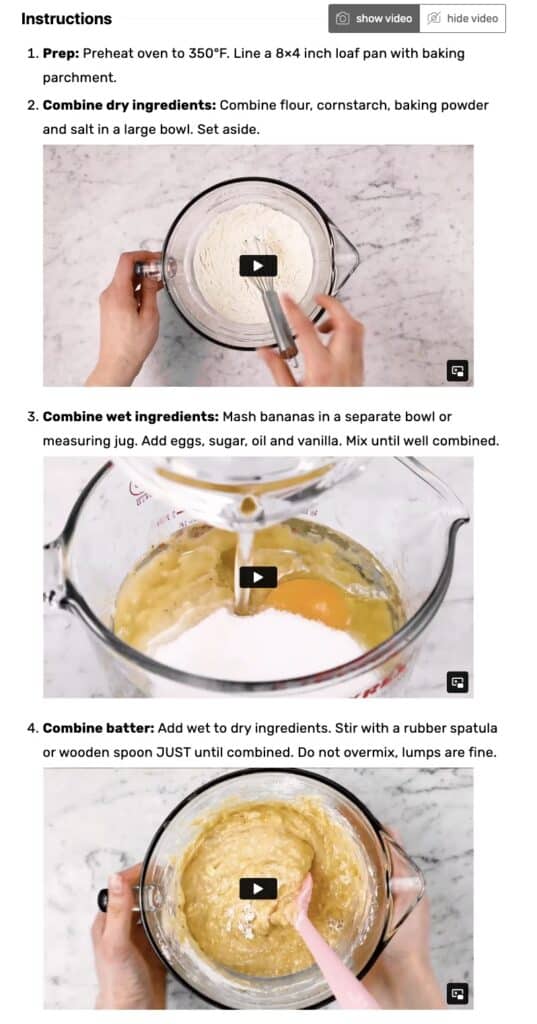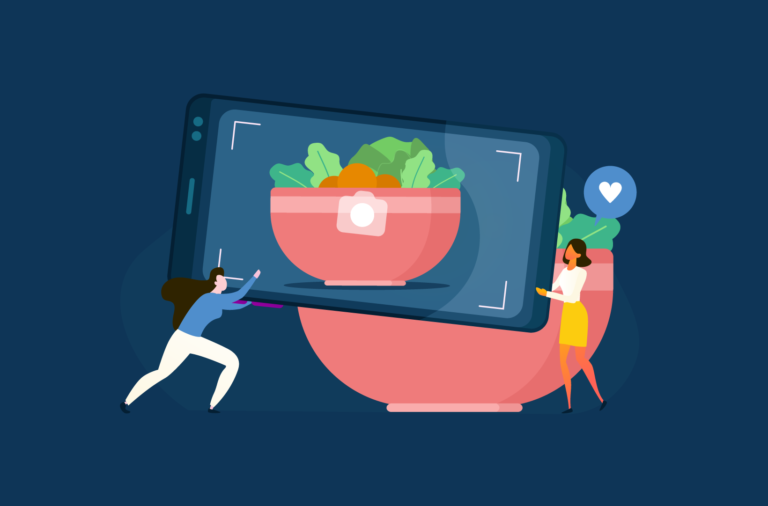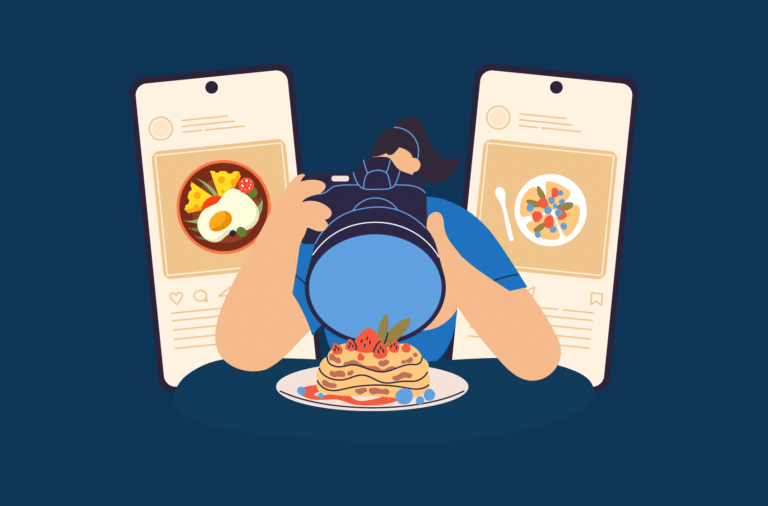In 2024, being a successful food blogger is about more than simply having your own website. You also need to know how to build your presence and reach across multiple platforms, including Instagram.
Creating food content that’s optimized for Instagram and knowing how to make the most of the platform’s features is a must, and this article unveils top tips for starting your food blogging journey on the platform. We’ll also discuss how to use Instagram in tandem with your recipe website so you can leverage more monetization avenues.
Why Instagram is an important channel for food bloggers
Instagram, with its array of images and videos, is a perfect place for food bloggers to share their content visually. It’s a platform where a single picture can tell a story, evoke a craving, or inspire a dinner choice. It’s also a platform where fellow food enthusiasts can build a community and connect. With Instagram projected to surpass 1.44 billion monthly active users by 2025, it’s clear why the platform is so inviting for food bloggers looking to make a mark.

For culinary creators, the benefits of leveraging Instagram are plentiful:
- The platform’s vast user base is not just large in numbers but also highly engaged. With millions of food enthusiasts scrolling and double-tapping every day, Instagram dishes out an opportunity for food bloggers to expand their reach exponentially.
- Furthermore, Instagram’s dynamic hashtag system is a launchpad for viral trends and a powerful tool for visibility. Using popular hashtags, food influencers can reach new viewers, grow their audience, and keep up with trends that make them popular.
- While direct monetization avenues like brand deals, ad placements, and affiliate links are lucrative, they only scratch the surface of Instagram’s potential.
- The income potential is significant – food bloggers can turn their Instagram into a revenue stream. A HypeAuditor report shows the potential earnings on Instagram: accounts with 1-10 thousand followers can average almost $1,500 monthly, which can skyrocket to $15,000 with over a million followers.
However, Instagram shouldn’t be the only tool in a food blogger’s collection. While it excels in visual storytelling, the essence of food blogging lies in providing accessible, detailed recipes.
It’s important to recognize that people usually start looking for recipes on search engines, not by searching for a specific food influencer.
A well-structured blog with strong SEO stands a better chance of appearing in these searches and is more likely to get new readers interested in your recipes. An online blog acts as a comprehensive recipe library, crucial for efficient content sharing.
Having a presence on Instagram is one of the best ways to boost the success of your food blog, as it’s a great way to build an audience and drive traffic back to a food blogger’s main website, where deeper monetization strategies can be integrated.
Setting up your food influencer Instagram account
Your food influencer journey begins with crafting your Instagram presence. Here’s a step-by-step guide to setting up your account:
- Choosing your username: Your Instagram handle is your brand’s calling card. Aim for a username that mirrors your blog’s name to maintain consistency and recognizability. It’s your first step in creating a cohesive brand image across platforms.
- Crafting your bio: Your bio is like a preview of your content. It should be appealing and informative, showing what your followers can expect from your posts. Use this space to share your culinary niche or what makes your blog unique, and don’t forget to add a dash of personality.
- Profile picture: Your profile picture is like a finishing touch, so choose one that stands out. Typically, a logo (if you have a branded one) or a personal picture works well to give your profile a face or identity that followers can connect with.
- Website link: In your Instagram bio, utilize the single direct link option to connect followers to your food blog for full recipes and more. This link is vital for driving Instagram traffic to your blog. Additionally, consistently guide followers to your website by using features like ‘swipe up’ in stories or including direct links in your posts, making it easy for them to go from a photo on Instagram to a detailed recipe on your blog.
- Switch to a business or creator account: A business or creator account unlocks professional features like Instagram Insights, which is the Michelin guide to understanding your audience. You’ll also get access to ad creation and shopping tags, essential for monetization.
- Brand alignment: To effectively align your brand across your blog and Instagram, ensure every element reflects your unique style. For instance, if your blog features a specific color palette, use similar tones in your Instagram photos for a cohesive look. Transform long-form blog recipes into engaging Instagram Reels or infographics that echo your blog’s tone and style.
- Consistency is key: Your online presence should be consistent. Ensure your Instagram aesthetic and posting schedule match the quality and rhythm of your blog.
Before you begin posting, consider reviewing Instagram’s business account best practices guide. It’s the key to effectively utilizing the platform’s business tools, ensuring your food blog’s Instagram account is set for success.
Creating unique and engaging content for your Instagram food blog
For food blogs, visual storytelling is an advantage. On Instagram, visual appeal is a necessity, with high-quality photographs, aesthetically plated dishes, and striking imagery often inspiring real-life culinary experiences.
Here are some proven strategies to create unique and engaging content for your Instagram food blog:
- Use Instagram’s features: Use all of Instagram’s features to show off your food. Share colorful pictures, videos of you decorating a cake, and quick recipe reels to appeal to different followers. High-quality Instagram food reels, especially, have emerged as a favorite that can quickly capture attention, directing users to your page, stories, or blog.
- Create authentic content: Content should be authentic, showcasing not only the final dish but the process, mistakes, and stories behind it. Sharing candid kitchen moments fosters trust and attracts followers.
- Keep up with the trends: Stay current with Instagram trends by following high-profile creators and the Instagram blog to ensure your content remains fresh and relevant. As food trends change, so do Instagram’s algorithm and format preferences.
- Provide a personal touch: A personal touch is a powerful ingredient. Don’t shy away from featuring your voice, face, or persona. Followers are often keen to interact with a profile that feels personal and approachable rather than a faceless brand.
- Use engaging captions: Captions add interest to your posts. Use them to get attention, tell stories, give cooking advice, or share anecdotes related to the recipe, or exciting snippets about the cooking process. A compelling caption can transform a passive viewer into an active follower.
- Bring in diversity: Lastly, variety is the essence of a great feed. Diversify beyond recipes to include meal prep tips, grocery hauls, and the tools of your trade. This shows your versatility and also positions you as a comprehensive food resource on Instagram.
Boosting your Instagram following
Growing a strong following on Instagram is more than just boosting numbers. It’s crucial for making your food content more visible and successful. Here are a few engagement strategies to grow your Instagram following:
- Post regularly: It’s important to keep showing up for your audience, ready to serve fresh and exciting content.
- Interact with your audience: Engaging actively with your followers by responding to comments, valuing their shares, and enjoying their likes can transform casual viewers into committed fans.
- Collaborate: Collaborating with fellow foodies on social media and engaging with followers through Q&As can expand your reach and turn casual viewers into loyal fans.
- Use hashtags: Using the right hashtags on Instagram is important – they can help the right people find your posts. It’s essential to research and use hashtags effectively. Simply filling your posts with popular hashtags isn’t effective. Also, avoid too many random hashtags, it can make your post less appealing.
- Provide high-quality visuals: Your blog and Instagram can complement each other. Written content can lead users to your visual Instagram, while captivating photos can draw them to the in-depth content of your blog.
- Cross-promotion: Cross-promotion is equally crucial. Let your followers on other social media platforms and your blog know about your Instagram adventures. A well-placed Instagram plug on your blog or Twitter feed can be the push a reader needs to become a follower.
- Expand your reach: Hosting giveaways, inviting user-generated content, and aligning with brands are also powerful ways to expand your reach. It’s a recipe for mutual growth that can lead to an influx of followers eager to see what’s next on the menu.
- Engage with your audience: Focus on crafting content that sparks follower engagement, such as comments and discussions, rather than just aiming for a higher follower count. This strategy builds a deeply invested and interactive community for your food blog, valuing quality interactions over mere numbers.
Monetization opportunities as a food blogger on Instagram
Monetization opportunities on Instagram
Monetizing your Instagram as a food blogger means transforming your passion into profit.
- You can integrate affiliate marketing into your content on Instagram, steering followers toward brand merchandise or promotions. Sponsored posts allow you to earn by spotlighting products relevant to your audience.
- You can also lure followers with snippets of exclusive content or premium offers, such as personalized cooking classes, leading them to platforms where they can purchase the full experience. Integrated features on Instagram, like shopping tags, facilitate these transactions, turning your food blog Instagram into a lucrative business venture.
Other avenues for making money on Instagram are:
- Securing brand deals by collaborating with companies to feature their products, thereby making money from sponsored content.
- Incorporating ad placements within your feed or stories, where businesses pay for visibility to your audience.
- Utilizing affiliate links in your bio or stories, driving sales for partners, and collecting commission.
- Enabling direct sales of your merchandise or recommended products through Instagram’s shopping feature.
Monetization opportunities beyond Instagram
While Instagram is a good starting point for gathering an audience, your main money-making opportunities come from your blog. Here, ad space, affiliate marketing, and exclusive content subscriptions can create a steady revenue stream.
There are also many other ways to make money from your food blog platform. By channeling the visual appeal of Instagram to drive traffic to these monetization channels on your blog, you can significantly amplify earnings.
Expanding your revenue stream beyond Instagram opens up numerous opportunities.
- Promote products that match your brand on affiliate marketing platforms to earn a commission on each sale.
- Forge partnerships for sponsored content, lending your voice and platform to brands for a fee.
- Utilize ads and affiliate links strategically on your blog to earn passively.
- By offering sponsored posts or highlighting sponsored products, you can directly monetize your influence.
How does WP Recipe Maker support monetizing your blog?
WP Recipe Maker is like a helpful assistant for your WordPress food blog. By integrating this plugin, you turn Instagram followers into repeat blog visitors by displaying SEO-friendly, aesthetically pleasing, and user-friendly recipe cards on your website.
WPRM has a comprehensive set of features for displaying blog recipes, from customizable templates to recipe collections and features such as adjustable serving sizes and nutrition info calculation. Its design is primed for SEO, ensuring your recipes rank high in search engine results with its recipe metadata and keyword features.
WP Recipe Maker is used by various WordPress food bloggers. Savory Nothings is an example of a blog that adds high-quality images and videos to their recipes, making their content more engaging and shareable.

Moreover, WP Recipe Maker also enhances the professional appearance of your food blog and opens up effective monetization channels through ads and affiliate marketing.
- For instance, users like The Flavor Bender utilize the plugin’s layout to strategically place ads within their recipes, seamlessly integrating them without disrupting the reader’s experience.
- Similarly, Joyful Healthy Eats effectively incorporates affiliate links within their recipes, guiding readers to recommended products and ingredients.
Understanding and making use of Instagram analytics
Instagram analytics and insights help food bloggers seeking to optimize and grow their online presence. This powerful tool provides abundant data from post-performance metrics to audience demographics, all designed to measure the impact of your content.
Insights such as engagement rates, reach, impressions, and website click-through rates are crucial. By analyzing this data, bloggers can find out which posts were popular, what time their audience is most active, and which hashtags brought in food lovers.
Application of this data means tailoring your content calendar around the posts that resonate with your audience, refining your photographic style to what gets the most love, or even adjusting the tone of your captions to speak directly to your core followers.
Next steps to kickstart your food Instagram
You now have a full menu of strategies on how to start food blogging on Instagram at your fingertips. From the initial setup of an appealing profile to creating captivating content and expanding your audience, all the way to driving traffic back to your main blog, where you can showcase full recipes and build out more monetization opportunities.
To make sure your website experience matches your Instagram experience, create stunning recipes and get started with WP Recipe Maker!






